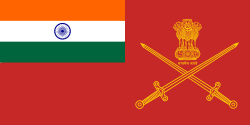| Battalion | Raising Date | Remarks | References |
|---|
| 1st Battalion § | 1778 | Raised as 8th Regiment of Bombay Sepoys. Underwent many name changes, was designated 101st Grenadiers, prior to present designation. Battle honours - Mangalore, Mysore, Hyderabad, Kandahar 1880, Afghanistan 1878–80, Burma 1885–87, Somaliland 1901–04, East Africa 1914–16, Egypt, Gaza, Megiddo, Nablus, Palestine 1917–18. Post independence – Gurais. Became 2nd Battalion, Brigade of the Guards in 1950. | [6] [7] |
| 2nd Battalion | 1796 | Raised in Calicut by Captain David Cameron as 13th Battalion, Bombay Native Infantry. Underwent many name changes, was designated 102nd King Edward's Own Grenadiers, before present designation. Battle honours – Egypt (1801), Kirkee (1817), Koregaon (1817), Persia (1857), Abyssinia (1868), Kut-Al-Amara (1917), Naga Village (1944). Nicknamed Second to None. | [8] |
| 3rd Battalion | 1768 | Raised as 1st Battalion, Bombay Sepoys. Underwent many name changes, was designated 108th Infantry, before present designation. Nicknamed Param Vir Chakra Paltan. Battle honours (pre-independence) – Mangalore 1783, Mysore 1793, Hyderabad (Sind) 1843, Afghanistan 1879, Aden 1916, Mesopotamia 1917, Kalewa 1944 and Fort Dufferin, Mandalay 1945; post-independence – theatre honour - Rajasthan (Sadhewala) in 1965 and battle honour – Jarpal in 1971. Major Hoshiar Singh was awarded the PVC. | [9] [10] |
| 4th Battalion | 1768 | Raised as 5th Battalion, Bombay Sepoys. Underwent many name changes, was designated 109th Infantry, before present designation. Battle honours : pre-independence – Mysore, Central India, Aden, Punjab, Multan, Burma, Afghanistan, Taungtha, Meiktila, Pwabwe, Sharqat, Pegu; post-independence – Asal Uttar (1965). CQMH Abdul Hamid was awarded the PVC. Nicknamed Param Vir Chakra Paltan and The Fighting Fourth. | [11] [12] |
| 5th Battalion | 1796 | Raised as 2nd Battalion, 6th Regiment of Bombay Native Infantry. Underwent many name changes, was designated 112th Infantry, before present designation. Nicknamed Finest Fifth. | |
| 6th Battalion | 1962 | Raised as 6/4 Grenadiers (Motorised) by Lieutenant Colonel D Greigson at Nasirabad in 1942. Disbanded 1943. Re-raised in 1962 by Lieutenant Colonel AB Jhadav at Jaipur. Nicknamed Joshila Sixth. | [13] |
| 7th battalion § | 1949 | Raised from Kutch and Saurashtra State Forces in camel mounted role, became regular infantry in 1957. Became 9th Battalion, Mechanised Infantry Regiment in 1979. Battle honour Chhadbet | [14] [15] |
| 8th Battalion | 1963 | Raised 1949 in Ahmedabad from state forces of Lunavada, Rajpipla, Baria and Idar, disbanded 1949, re-raised 1963 in Jaipur under Major BS Brah. Battle honour – Chakra (1971). Nicknamed Chakra Battalion and Gallant Eighth. | [16] |
| 9th Battalion | 1954 | Mewar, ex-State Forces unit | [17] [18] |
| 10th Battalion | 1800 | Raised 1st Battalion, 7th Regiment of Bombay Native Infantry. Underwent many name changes, was designated 113th Infantry, before present designation. Training Battalion. | |
| 11th Battalion | 1963 | Raised at Ajmer as a Territorial battalion in 1922 (1st battalion, Ajmer Regiment), disbanded in 1948, re-raised in 1963 in Jaipur by Lieutenant Colonel Racchpal Singh. | [19] |
| 12th Battalion | 1964 | Raised at Nasirabad by Major NS Sidhu. Lieutenant Colonel Hari Singh was the first commanding officer. Nicknamed Thundering Twelfths. | [20] |
| 13th Battalion | 1889 | Raised as the Ganga Risala by Maharaja Ganga Singh of the Indian state of Bikaner. | [21] |
| 14th Battalion | 1965 | From 34th Training Unit (raised 1943), disbanded 1946, re-raised 1965. | [22] |
| 15th Battalion | 1966 | Raised in Nasirabad by Lieutenant Colonel PS Mahurkar. Nicknamed The Dare Devils | [23] |
| 16th Battalion | 1966 | Raised in Babina under Lieutenant Colonel NB Jayaram . | [24] |
| 17th Battalion § | 1966 | Raised as a camel battalion in Bikaner under Lieutenant Colonel KS Harihar Singh. Nicknamed The Desert Hawks. Motorized Infantry Regiment. Became 24th Battalion, Brigade of the Guards in 2023. | [25] |
| 18th Battalion | 1976 | Battle honour – Tiger Hill and Tololing. Nicknamed Param Vir Chakra Paltan after the PVC won by Grenadier Yogendra Singh Yadav. | [26] [27] |
| 19th Battalion | 1979 | Nicknamed Utkrisht Unnees. | |
| 20th Battalion | | Nicknamed Double Axe. | |
| 21st Battalion | 1985 | Nicknamed Awwal Ekkis. | |
| 22nd Battalion | 1988 | Raised in Jabalpur. Nicknamed as Bravest of the Brave and Ashok Chakra Paltan – has won two Ashok Chakras. | [28] |
| 23rd Battalion | | | |
| 24th Battalion | | | |
| 25th Battalion | 1 July 2014 | Raised at the Grenadiers Regimental Centre in Jabalpur, the battalion was established under the command of Colonel Vipul Singh Rajput. Nicknamed Parakrami Pacchees. | [29] |
|
| 12 Rashtriya Rifles | | | |
| 29 Rashtriya Rifles | | Nicknamed Cobra Paltan. | |
| 39 Rashtriya Rifles | | | |
| 55 Rashtriya Rifles | | | |
| 118 (TA) Battalion | 1939 | Raised at 7 Central Provincial Urban Infantry Battalion (Indian Territorial Force). Present designation since 1949. Located at Bhusaval, Maharashtra | [30] [31] |
| 123 (TA) Battalion | 1956 | Raised by Lieutenant Colonel Zorawar Singh at raised at Senapati House, Jhotwara. Located at Jaipur, Rajasthan. Nicknamed Jaipur Terriers. | [32] [33] |
|












